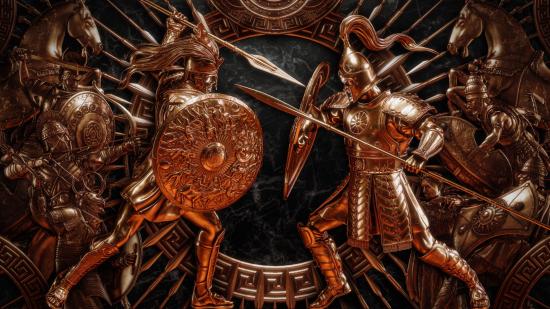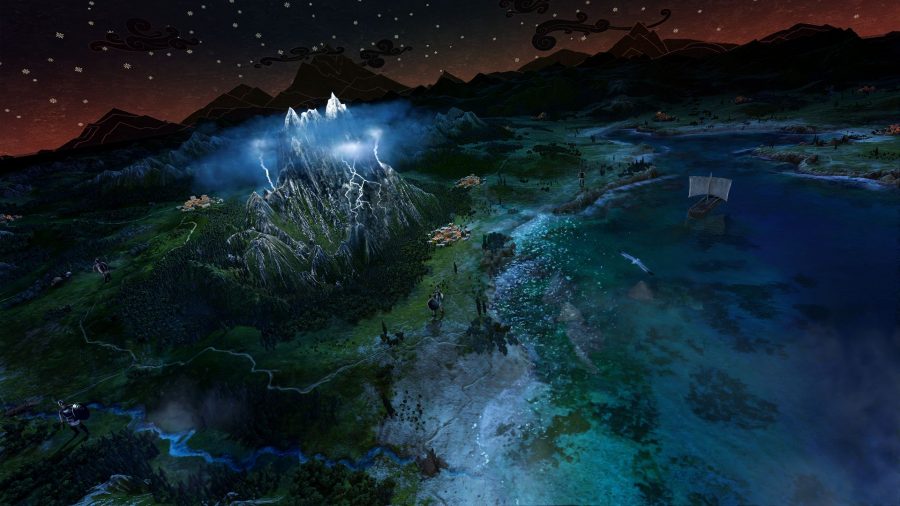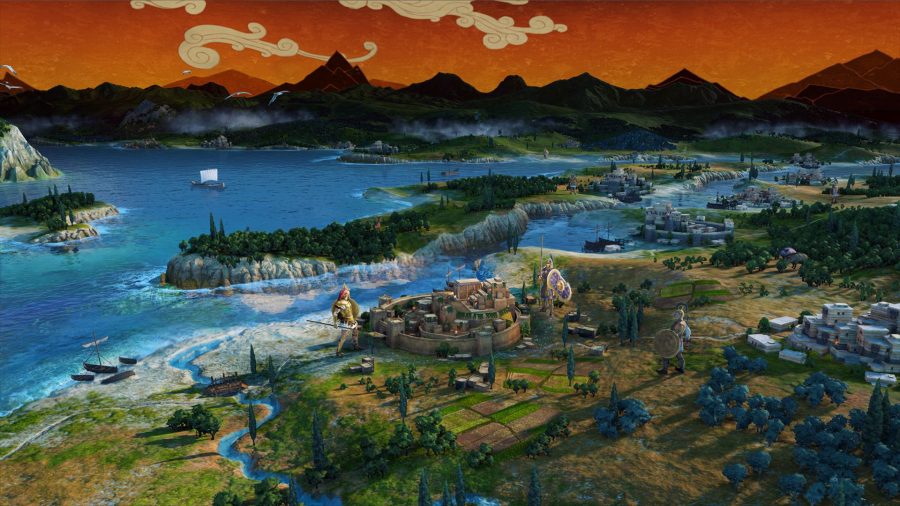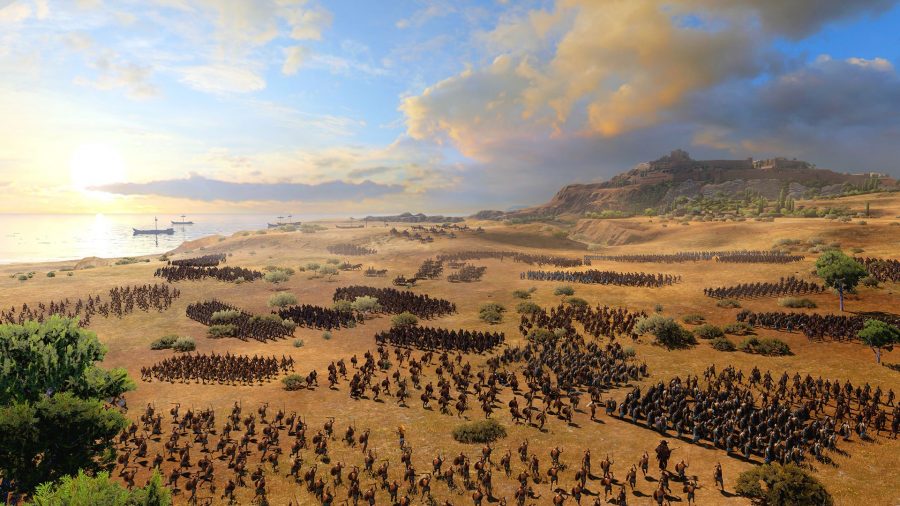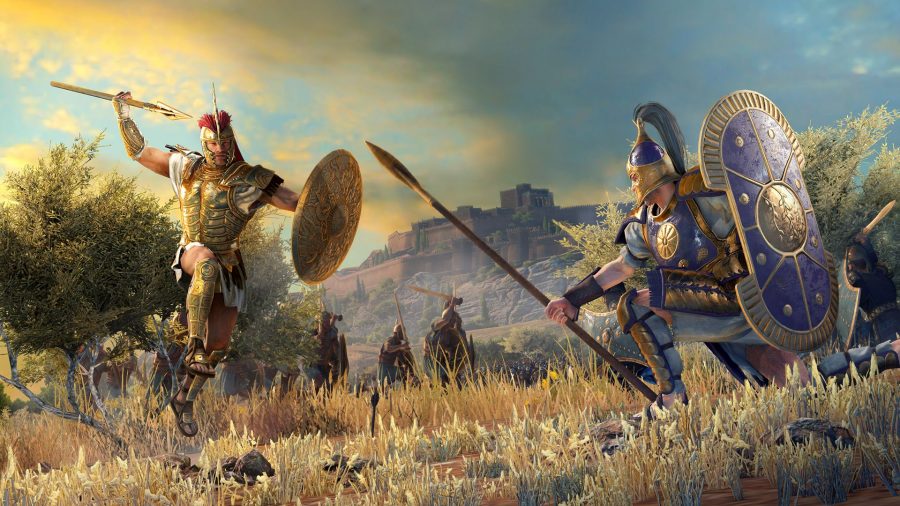I remember when Total War Sagas were announced. I liked the idea of these more focused Total Wars, and when we heard the first would be set against the Viking invasion of Britain, I was thrilled. Then I saw it, and how closely it resembled Attila – and a lot of my hype fizzled out. Though I stand by our review, which hailed its gameplay innovations, I do find it difficult to return to.
This is one of the few unfortunate results of Total War: Warhammer’s outrageous success; it was such a leap in Total War’s beauty that going back was impossible for many fans. Having seen A Total War Saga: Troy at Gamescom this year, I’m as sure as I can be without having played it that it won’t have that problem. The demo was one of the best-looking strategy games I’ve seen.
Lead game designer Todor Nikolov confirms that Troy will run on a modified version of the Warhammer 2 engine, and my word, it looks wonderful. Colours are warm and bright, the Mediterranean is clear and sapphire-hued (trivia side-bar: Homer, writer of the most famous chronicle of the Trojan War, The Iliad, calls it the “wine-dark sea” and doesn’t appear to have had a word for the colour blue).
There are some gorgeous stylistic choices, too. The skybox is decorated with red and black figures inspired by Greek amphorae. The fog of war features quotations from The Iliad and is burned away as you explore, to represent you revealing “the real-world truth behind the myth”.

That speaks to the game’s approach to the mythology – which, thanks to Homer, is practically inseparable from popular understanding of the Trojan War. CA says it’s considering what may have occurred in reality to inspire the wonderful, fantastical stories of the period. The Minotaur, for instance, might’ve been a big, dangerous warrior who wore a mask shaped like a bull’s head to intimidate his enemies. Therefore, that’s how he will appear in Troy.
Nowhere is this approach more clear than in the game’s interpretations of the gods. Yes, they will ‘exist’ – specifically, Ares, Athena, Apollo, Poseidon, Aphrodite, Hera, and Zeus – and you’ll gain or lose their approval through your actions, but they won’t have a material impact on the game. Instead, they will affect people, like your troops and other faction leaders. If you’re favoured by Ares, for instance, your units will gain morale, believing that the god of war himself is on their side. It’s an entirely credible representation of phenomena which didn’t physically exist, yet had a very real impact, and will do in the game.
The home of the gods itself, Mount Olympus, is on the campaign map, as are other sites of mythological significance. Nikolov says you’ll receive certain gameplay bonuses – some varying according to your faction leader – if you can hold these sites. “If you manage to, for example, capture the region which holds the tomb of Hercules, Aeneas can claim that he can commune with Hercules, and bestow his wisdom upon his troops.”
Aeneas was a Trojan hero and star of the Aeneid, a Homer-imitating epic poem written by Virgil in one of many examples of Romans ripping off Greek culture. He’ll be one of the Trojan faction leaders along with Hector, son of Troy’s King Priam, and two others. They’ll be opposed by four Greeks (or, in Homeric parlance, Achaeans): the self-styled ‘king of kings’ Agamemnon, who claims leadership over all the Greeks; his brother Menelaus, king of Sparta and cuckolded husband of Helen; cunning Odysseus, who had the idea that the Trojans needed a giant wooden horse and just, like, the worst journey home; and, of course, Achilles.
While these are the most essential characters to the story, The Iliad has a cast of dozens of kings and heroes. Notable omissions from the game include Patroclus, Diomedes, Ajax, and Nestor on the Greek side – asked about their possible arrival as future DLC, Nikolov says “it could be something we are discussing.”
I hope the world won’t feel too empty with only eight playable factions at launch – CA says the beautiful map is “on par” with some of the largest games in the series in terms of pure size. Troy is at its dead centre, with the overall theatre encompassing mainland Greece, Crete, and most of modern Turkey.
These characters were essential to the drama in The Iliad, which is basically a soap opera in a bronze age war. If that sounds familiar, it was one of the points CA emphasised about Total War: Three Kingdoms, which is just one of many reasons why Troy makes so much damn sense as the studio’s next project. Nikolov says a number of innovations from Three Kingdoms will be carried over to Troy: “for example, we have recreated some diplomacy-related features which the players really liked. Some quality-of-life stuff.”
But leave diplomacy to megalomaniac wimps like Agamemnon, as Achilles might say. For most of those characters, their reason for being is to fight. In more elegant extensions of sensibilities developed in Three Kingdoms, expect these legendary heroes to have unique units, battlefield abilities, and wide-ranging campaign mechanics.
Achilles, for instance, can recruit the widest variety of elite attacking units, including his uniques: the Myrmidons. His thirst for glory grants character loyalty, cheaper units, and greater diplomatic influence as he slays other characters who might challenge his supremacy, while his ‘hot blooded’ mechanic mechanises his infamous mood swings: if he’s ever insulted, expect penalties in diplomacy and trade while he sulks.
But you shouldn’t assume too much from The Iliad about how the war shakes out. The game begins with Hector’s brother Paris taking Helen from Menelaus, and relationships are as polarised as you’d expect, but they’re not immutable, nor need they lead to a single outcome. Achilles and Agamemnon quite famously don’t get along, for example, and you might find that one turns on the other long before they make it to Troy.
Hector represents the faction of Troy, but doesn’t gain control of the city until he proves himself to his father, King Priam, by completing a series of tasks. And yet, Nikolov says you can betray your people and take the city by force. “It’ll be extremely difficult to pull off, because there are many factions near the city that are friendly to it. But it could happen. You get to tell the story of the Trojan War, or you get to make your own Trojan War.”
CA concludes its presentation with a showdown between Hector and Achilles. There’s not a lot of cavalry about, as most horses of the time would’ve been reserved for chariots (there are some chariots). Armies are dominated by infantry, and accordingly CA promises a more granular focus on infantry tactics and troop types. Both mud and long grass have been added as battlefield terrain types as part of this, with the former impeding movement especially for heavy troops, and the latter enabling certain light troops to hide. The battle culminates in an epic duel between Hector and Achilles themselves, with fluid animations in the style of Three Kingdoms.
I’ve got to be honest: I’m already hugely excited for this one. And unlike Thrones, that’s after having seen what it looks like. There’s just one thing I’m not sure about, though, and that’s the hyper-stylised look CA is seemingly taking with the heroes. Achilles’ helmet looks jarringly alien to the period, with its flowing, stringy plumes and crest of jagged teeth. I’m not about to get boringly over-precious about historical accuracy given that gods and Minotaurs sort of exist here, but it does seem a little inconsistent with that ‘truth behind the myth’ approach, and with lovely authentic touches like the amphorae (although, I’m reasonably sure that they didn’t actually appear in the sky).
For more, check out our full A Total War Saga: Troy interview, or head to the game’s Steam page here. The game is due for release next year.
